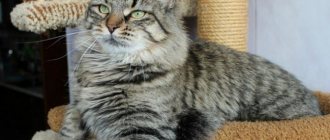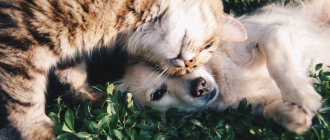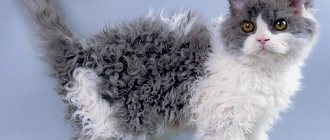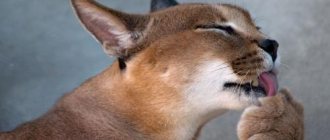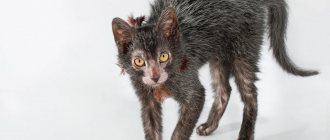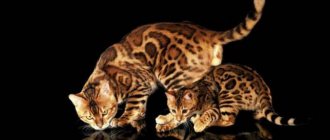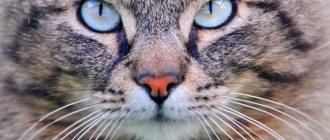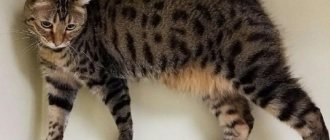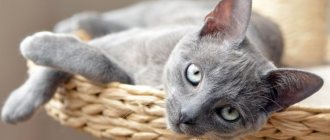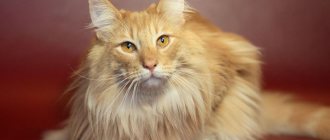10614Administration
3
Often, pet owners are faced with various behavioral problems of the latter. Cats that are naturally willful, but happily get along with people, may suddenly begin to show aggression. In fact, nothing happens for nothing, and if a cat attacks a person, then there are reasons for it. The owner of the animal can install them, but quite often only a veterinarian can do this, so do not put off going to the veterinary clinic. Especially in cases with a sharp change in the cat’s behavior.
The most famous breeds of tabby cats
There is no such breed - a tabby cat. English-speaking felinologists use the word “tabby” to describe the characteristic pattern found on the fur of absolutely all tabby cats: both domestic and barn cats.
Many mustachioed and striped animals were lucky enough to be born and live in comfortable conditions due to belonging to one breed or another.
Asian tabby
Spotted tabby
An artificially bred breed, a hybrid of Burmese, Persian and Abyssinian cats.
The creators of the Asian tabby, British felinologists, sought to develop a completely new variety. By crossing cats of popular breeds, they sought to get a smart, neat cat with the manners of an aristocrat. Proud, but not arrogant.
The result was a refined and miniature (especially for females), but at the same time strong and well-built specimen weighing from 4 to 7 kg. The body of representatives of the breed is covered with short, thin, soft and delicate hairs of light blue, gray-blue, lilac, black, dark and soft red, tortoiseshell, caramel, apricot, cream and other shades.
You can distinguish an Asian tabby from a regular gray striped cat by the stylized image of a scarab beetle on the forehead, the “broken necklace” around the neck and the characteristic pattern on the fur coat. There are four types of patterns, the carriers of which are:
- spotted tabby cat. The body of the animal is covered with dark spots that differ in shape and size. The spotted tabby's coat is almost always light in color, so the dark pattern stands out clearly and is well defined;
- marbled tabby. It can be recognized by the characteristic spiral pattern on the sides. If you look at a marble tabby from a distance, the ornament blurs and resembles a fuzzy cage;
- brindle tabby cat. The animal’s body is lined with richly dark parallel vertical lines;
- ticked tabby. Each hair on the fur coat of representatives of this subspecies is colored in different shades, contrasting with each other. Representatives of this subspecies have stripes only on the tail.
Cymric
This is sometimes called the Cymri cat, bred in Canada in the 60s. last century.
The ancestors of the Cymrics were cats with a gene mutation and the rejected long-haired offspring of their Manx cousins. As a result, Cymrics are born either tailless or short-tailed. Experts characterize the length of the Cymric's fur as semi-long.
Pixie bob
Pixie Bob - a cat without a tail
For the first time people started talking about cats of this breed in 1985 in the USA.
The ancestors of the pixie-bob are a domestic cat named Pixie and a wild red lynx (Americans call this type of lynx bobcat). The breed is considered a natural hybrid. Characteristic differences of the breed are tufts on the ears and a short tail. Sometimes the tip is decorated with a fluffy mop of wool.
For your information! The external resemblance to a lynx attracted the interest of representatives of the International Cat Association TICA, thanks to which pixie-bob cats participate in international championships along with their purebred relatives.
Maine Coon
A natural rock formed in the American state of Maine under the influence of harsh weather conditions. This is the official version of the origin of Maine Coons. This breed was first mentioned in American literature in the early 60s. 19th century Maine Coons gained worldwide popularity only at the end of the last century. A distinctive feature of this breed is its prolonged puberty. Cats of this breed become adults only at the age of 5 years.
Note! An adult male living in the same territory as a cat and kittens looks after the offspring no less carefully than a mother cat
Toyger
One of the most prominent representatives of striped purebred cats is the toyger. The name speaks for itself. The toyger is often called a toy tiger. Despite the resemblance to a predatory animal, the breed is completely domesticated. The American D. Sugden is considered to be the breeder of toygers.
Toyger - mini version of tiger
By crossing short-haired tabby cats with Bengal relatives, Judy sought to achieve maximum similarity of the new type of cat with a tiger. As you can see, she succeeded.
How to reconcile fighters?
It is impossible to force pets to treat each other with tenderness and trust. But you can minimize the problem by eliminating the cause of the conflict - that very throne of omnipotence.
Extreme measures are to destroy it to the ground: replace the sofa favored by cats with other furniture, block access to the window sill, etc.
But it’s not always clear why cats are fighting – are they fighting for a specific place or for the entire apartment, for a person’s attention or for territory? Or maybe out of boredom? Therefore, it is easier to artificially delimit possessions by providing each cat with a personal “throne”: a separate tray, a separate bowl, a couple of high play complexes, several loungers and houses
But this is not always enough; sometimes a little more effort is required from the owner:
feed cats at the same time, in different places, but at the same height
Rivals will fight for the bowl that is higher, and under equal conditions, the hooligans will switch their attention to food; the same goes for vacation spots. All houses, beds and play complexes should be located at approximately the same height. If cats choose the same bed, move it to another place or temporarily remove it; keep windows closed and interior doors open
A retreating cat should be able to retreat, this will significantly reduce the frequency and severity of conflicts. In addition, various shelves, steps, ladders, etc. help. If the owner is not at home and the cats are fighting, what should I do? The distraction method will work here. For example, interesting toys left in secluded corners: a mechanical mouse, an automatic laser pointer, birds on springs, etc. Toys must be extremely attractive so that curiosity overcomes the desire to sort things out. And there should be several of them, so that an interesting thing does not become the cause of a new conflict; If cats get into a fight in the presence of the owner, it is necessary to sharply and rather harshly distract the hooligans from each other. You can throw half a glass of water on the hissing woolen thing or throw a thick, heavy blanket over the cats. Of course, scaring your pets is not very right, but it is better than treating torn ears and bloody faces; If cat fights continue despite all the efforts of the owner, one of the pets will have to find a new home or resort to sterilization (castration). Deciding on an operation is not easy, but such drastic measures almost always work: castrated (sterilized) animals gradually lose interest in the struggle for territory and power, and this is the right path, if not to friendship, then at least to friendly relations with the former “enemy.”
If cats choose the same bed, move it to another place or temporarily remove it; keep windows closed and interior doors open. A retreating cat should be able to retreat, this will significantly reduce the frequency and severity of conflicts. In addition, various shelves, steps, ladders, etc. help. If the owner is not at home and the cats are fighting, what should I do? The distraction method will work here. For example, interesting toys left in secluded corners: a mechanical mouse, an automatic laser pointer, birds on springs, etc. Toys must be extremely attractive so that curiosity overcomes the desire to sort things out. And there should be several of them, so that an interesting thing does not become the cause of a new conflict; If cats get into a fight in the presence of the owner, it is necessary to sharply and rather harshly distract the hooligans from each other. You can throw half a glass of water on the hissing woolen thing or throw a thick, heavy blanket over the cats. Of course, scaring your pets is not very right, but it is better than treating torn ears and bloody faces; If cat fights continue despite all the efforts of the owner, one of the pets will have to find a new home or resort to sterilization (castration). Deciding on an operation is not easy, but such drastic measures almost always work: castrated (sterilized) animals gradually lose interest in the struggle for territory and power, and this is the right path, if not to friendship, then at least to friendly relations with the former “enemy.”
And remember that love is capable of miracles: communicate with your pets equally affectionately, do not scold the instigator of the conflict, do not feel sorry for the victim. Cats should feel the same warmth and care. Sitting together in front of the TV, playing games together and having “conversations” before bed are an excellent remedy against aggression from domestic predators.
Brachycephalic cat breeds
List of brachycephalic breeds:
- British Shorthair;
- Scottish lop-eared;
- Himalayan;
- exotic;
- Persian
Exotic cat
CFA (Cat Fanciers Association) annually publishes a ranking of the most popular breeds. For many years, kittens with flattened faces have been at the top of the rankings, which indicates their popularity.
British Shorthairs with a slightly flat nose
British shorthair cat
The British cat is characterized by a round, plump muzzle, slightly sagging cheeks, and small, neat ears. The animals have a squat, dense body and strong limbs.
In British cats, brachycephalic syndrome manifests itself to the least extent. They are distinguished by a short, wide and straight nose, which forms a vertical line with the chin.
British Shorthair cats are self-sufficient, they tolerate loneliness calmly and do not like noisy companies and active games. They are great for singles who spend a lot of time at work. These animals have a sense of self-esteem, so they expect respect from others.
https://youtube.com/watch?v=XNYtB9Ill8o
Scottish Fold: almost normal profile
Representatives of the Scottish Fold breed have a slightly flattened muzzle, and their profile is close to normal. The calling card of the Scottish Fold is drooping ears and a surprised expression in the eyes. The weight of an adult animal is 4–5 kg, the physique is correct and powerful. The head is round, proportional to the whole body. Hanging ears visually make the head even rounder.
Scottish fold cat
Scots are always loyal to their owners, they are obedient, easy to train, calm, and rarely release their claws. At birth, babies' ears are straight and erect; they droop later. Sometimes this does not happen; such individuals are classified as a related breed, the Scottish Straight.
Some representatives of the breed have thicker tails than normal, which is considered their main and only drawback. Animals with thick tails have too massive hind limbs, which interferes with normal movement.
Luxurious Himalayan cat: Persian face, Siamese color
The Himalayan cat is an amazing, noble animal, a direct descendant of the Persian. The breed was bred artificially by crossing Persian and Siamese cats. The cats inherited the appearance of the Persian and the royal coloring of the Siamese. The breed is officially recognized by only two felinological associations - TICA and CFF.
Himalayan cat
Distinctive features of appearance and physique:
- rich blue eye color;
- color point coat color - dark paws, tail, muzzle and ears, everything else is light;
- long fluffy fur;
- large rounded body and short limbs.
Himalayans have a calm, gentle character. They are similar to Persians, but more active, they love to play and run after toys. They get along well with children as long as they don't cuddle them too much.
Plush big-eyed exotic
The American Shorthair Exotic cat, or Exotic, is an unusual cross between the American Shorthair and the Persian breed. Exotics are surprisingly cute, looking like plush toys. They inherited the anatomical features of the Persians - a flattened muzzle, an upturned nose, neat ears, and large round eyes. Exotics have a dense, squat body and short limbs.
Best articles: What is a river drainage basin called in geography? Definition and examples
Exotic
These are affectionate, calm, flexible and very playful animals. In adulthood, they remain active and enjoy playing with their owner. Very attached to people. Exotics are quiet, rarely meow and do not bother their owners. They get along well with people and other animals, including dogs.
Unlike Persians, who have long, thick fur, exotics are easy to care for. Caring for plush short fur does not require much effort or time. That is why exotic cats are popularly called Persians for lazy people.
Classic brachycephalic – Persian
The Persian breed is very common in the post-Soviet space. Cats look very large due to their incredibly fluffy fur. These are lazy, clumsy animals that love peace.
Persian catThick coat requires careful and regular care. It is necessary to comb your pet frequently to avoid the formation of mats that will have to be cut off. A well-groomed coat looks gorgeous, but it takes time and patience.
Exterior of a Persian according to the breed standard:
- large body, developed muscles;
- small triangular ears;
- weight of an adult cat – up to 7 kg;
- round head;
- flattened muzzle and upturned nose (at eye level);
- large round eyes yellow or green;
- short limbs.
"Classics of the genre
If the owner is not particularly concerned about finding a rare, original name for his mustachioed-striped pet, then you can limit yourself to a list of the most common cat names:
- Barsik;
- Boris;
- Vaska;
- Basil;
- Kuzya;
- Kuzma;
- Kotofey;
- Marquis;
- Murzik;
- Semyon (Semka, Semushka);
- Stepan (Styopka, Stepashka);
- Timofey;
- Timka;
- Tishka;
- Timosha;
- Filya;
- Philemon.
In principle, most domestic cats have a similar color, so traditional nicknames suit them perfectly.
Domestic cat
In all the variety of cat breeds, rare and not so rare, we should not forget about ordinary short-haired cats. Those same gray or red stripes that come to our doors in the hope of finding a best friend and a caring owner. They are in no way inferior to their purebred brothers, and in endurance, intelligence and kindness they often surpass them. By giving a home to a homeless cat, you will gain yourself a loyal and affectionate friend for many years.
An affectionate purr can support you in difficult times and give you a boost of good mood. These cats have long been considered a symbol of home comfort and warmth. This is confirmed by numerous paintings and miniatures with images of cats. All cats in the world have the same ancestors, which means that the differences between purebred and outbred cats are not that great. A small pet tiger will decorate any home, save you from loneliness and bring bright colors to your life.
https://youtube.com/watch?v=D3wi5P_V-vc
Tabby cats
Disease
If pooping on the bed is a new behavior for your cat and there have been no recent changes in the family, first look for illness. Some health problems are very time sensitive, so knowing what to look for can help.
There could be several medical reasons why your kitty is interested in your bed as a litter box. Here are some of the diseases that could be the culprits.
- Intestinal parasites
- Irritable bowel syndrome
- Food sensitivity
- Hypothyroidism
- Diabetes
- Liver disease
- Cancer
Toyger
Bred by the daughter of Jeanne Mill, the creator of Bengal cats. The difference between related breeds is insignificant, except for color. The amazing tiger coat of the toyger impressed experts so much that they didn’t immediately believe it was real! Without exaggeration, this is the most striped cat breed in the world. Care, illnesses like Bengals.
The character also repeats the older “sister” - playful pets who are active until old age. They easily find a common language with friendly animals and people. The hunting instinct is developed. They need space, a play area, and walks. Like Bengals, it is advisable to feed Toygers meat - they do not digest ready-made food well.
The most popular cat breeds without a tail
Unusual cat breeds
The most aggressive and evil cat breeds
Recent studies have proven the influence of the tabby gene on the functioning of the immune system. It is not yet clear how the connection is realized, but such pets are more resistant to viruses and oncology. Of course, this does not mean that you can’t monitor the health of your tabby cat.
Norwegian forest
A large, strong, muscular, very agile cat in a luxurious, very dense coat with water-repellent outer hair covering the back, sides and tail. Breed standards allow many colors, but tabby is one of the most common and, admittedly, the most “suitable” to their harsh appearance.
The ancestors of the Norwegians are feral domestic cats, inhabitants of the forests of Scandinavia for hundreds of years. How they got to those harsh lands is not known for certain. Research has only proven their relationship with Turkish Angoras.
The Norwegian Forest cat is not an old breed, although ideas about its selection appeared back in the 30s of the last century - when it became obvious that the cats of the Scandinavian forests were in danger of extinction. But the breeding program was developed only in the 70s, and was quite successful. Now Norwegians are recognized throughout the world and are the pride of Norwegian breeders (hence the name).
History of the American Shorthair cat breed
American Shorthair
Unfortunately, this legend is not documented, which cannot be said about the widespread version of the origin of the breed. The first cats, which may have become the ancestors of the “Americans,” appeared in the New World at the beginning of the 17th century along with a group of English Protestants. They arrived in America on the Mayflower and founded Jamestown, the first British settlement. This is evidenced by entries in journals that have survived to this day since 1609.
Once in a different climate, animals were forced to adapt to new living conditions. The size of cats has increased in comparison with their European counterparts, and their fur has become stiffer and thicker. While whiling away their days on farms and ranches, near houses and barns, the ancestors of American Shorthairs could increasingly boast of good health
The settlers noticed this and soon began to value the “stability” of the animals along with their excellent skills in exterminating rodents
Until the beginning of the 20th century, breeding of cats took place in free conditions: no one cared about the exterior and purebred pedigree, or made any attempt to standardize the breed. The ancestors of the “Americans” retained similarities with their British relatives, but were distinguished by a more elongated and athletic physique. In addition, the animals were hardy, intelligent and fearless, which made them valuable material for breeding. Soon, US breeders realized that they needed to preserve the breed. Thus began the breeding of American Shorthair cats.
American shorthair kitten
Fans of these amazing animals began to acquire outstanding representatives of the breed and form ideal breeding pairs. This would allow the cats to maintain their remarkable appearance and docile nature. In 1904, the CFA registered Buster Brown, a direct descendant of the “British” who came to the United States with the colonists. From that moment on, American breeders developed a clear cat breeding program.
Its results became clear by 1930, when, with a relatively small number of generations, it was possible to “enrich” the breed with many remarkable colors. Among them was silver – a legacy from the Persians. Breeding American Shorthair cats also played an important role in the lives of their brothers. With the participation of these animals, it was possible to create new breeds: Snowshoe, Bengal, Scottish Fold, Ocicat, Bombay, Devon Rex, Exotic, Maine Coon, etc.
Best articles: Fauna of Chernobyl - characteristics, mutations, photos and videos
In the middle of the 20th century, CFA members published the first catalog, which included about fifty representatives of the breed. At that time she was known as a domestic shorthair. Under the same name, the animals first participated in the 1966 exhibition. Shawnee Trademark won, inheriting the title of “Cat of the Year.” At the same time, they decided to rename the breed in order to reflect its true “American” character and thereby separate it from its other short-haired counterparts. Despite this, cases of cats being registered under the previous name occurred until 1985.
American Shorthair cats love to lie around and sleep, that is, they are quite lazyIn 1984, the handsome Mr. H won a similar victory, and in 1996, Sol-Mer Sharif. The end of the 20th century was significant for representatives of the breed. Over the course of two decades, American shorthair cats have gracefully climbed to the top of the rankings of the most popular breeds and have chosen a place in the top ten shorthair favorites in the United States.
The CFA organization has about a hundred registered kennels that specialize in breeding this breed. Moreover, most of them are concentrated in America: breeders have entrusted their national treasure to a few. The history of American shorthair cats in Russia began in 2007 with the appearance of a breeding pair - the cat Lucky and the cat Cleopatra, brought from the KC Dancers cattery.
Official nurseries can boast of worthy producers originally from the USA. Despite the few litters of American Shorthairs, representatives of the breed are becoming more and more common
Russian breeders are working hard to ensure that these cats take an important place in people’s hearts and subsequently win as many victories as possible at specialized exhibitions. So far these are just dreams: the European “cat” organization FIFe still does not officially recognize short-haired “Americans”
Representatives of this breed are found less frequently in Russia than, say, in Japan.
Friendship
The most favorable development of the situation, except in the case where animals grow up together from a very young age, is the immediate sympathy that arises between them.
This happens when a kitten appears in a house with an adult cat. And then the owners do not have to think about how to make friends between a cat and a kitten, since thanks to maternal instinct, a cat is extremely rarely aggressive towards the baby. On the contrary, she, as a rule, takes him under her wing. But if a kitten is purchased for a home with an adult cat, then there is a chance that at first the old-timer will ignore the newcomer. But later, a warm and strong friendship can also begin between them.
Tabby color - characteristics and distribution
Tabby is a striped color, which in most cases is characteristic of ordinary cats, the so-called yard cats. But it is often found in the colors of purebred animals. For all its apparent complexity and chaos, this color has certain mandatory elements that are found in absolutely all striped purrs, for example, a pattern in the form of the letter “M” on the forehead.
And at the same time, the pattern can be surprisingly varied, which will depend on the shade of the background, the color of the stripes themselves and the shape of individual elements
- Balinese cat;
- Bombay cat;
- chartreuse;
- Havana Brown;
- Russian blue cat;
- Korats and some others.
But let’s return to those who are very good in a striped fur coat.
European Shorthair
The second name is Celtic cat. This is an intelligent and very dexterous animal, with strong paws and a well-developed chest. Overall, this is a magnificent beast that evolved naturally. And any signs of crossbreeding with a European Shorthair cat are serious faults.
Representatives of this breed are excellent hunters, but as far as character and behavior are concerned, they will be purely individual for each specific pet. For the most part, Celts are friendly, affectionate and kind. They are unpretentious in care and are quite strongly attached to their breadwinner.
The European Shorthair cat has excellent health and strong immunity, especially in relation to infectious diseases.
Siberians
The mighty “woolly” Siberians are representatives of a pure breed with an excellent immune system. When you look at them, it seems that they are able to withstand absolutely any frost - their coat is very thick, long, impermeable to moisture and incredibly warm.
Siberian cats can come in a variety of colors, including tabby or common tabby. Its main features will be:
- on the forehead there is a pattern in the form of the letter “M”;
- button-shaped spots on the stomach;
- stripes on the belly and paws.
If we talk about the rest of the body, then there should be no stripes on it.
When mating striped Siberians, this pattern is transmitted stably and is preserved for many subsequent generations.
- on the forehead there is a pattern in the form of the letter “M”;
- on the stomach there are spots in the shape of buttons, located in two rows;
- there are several continuous “necklaces” on the neck;
- one stripe on the back and two parallel stripes on the sides;
- several clear thin stripes running from the back to the stomach.
Black Brindle Siberians have quite expressive eyes, a raccoon tail and black paws.
British
The cutest and most attractive creature is the British tabby cat. It’s not without reason that this particular representative of the cat world was chosen to advertise Whiskas food. It is quite difficult to describe all types of British tabby colors, since there are a lot of them and each has its own background, stripe color and line features. Here it is only worth noting that according to the breed standard, British tabbys are divided into three types: brindle, spotted and marbled.
British cat with black and silver brindle color
And here we see red marble color
The color of this magnificent Briton is called black spots on silver
As you can see in the photo, all tabby cats of the British breed have a pattern in the shape of the letter “M” on their foreheads and stripes on their paws. Otherwise, the patterns on their bodies differ in many ways.
If we talk about the morals of British cats, they are much more independent than representatives of other breeds. They tolerate the long absence of their breadwinner quite calmly and are not particularly worried about this. The British share some of the qualities of English lords - they are reserved and have a sense of self-esteem. Moreover, the latter quality is expressed even in small things - if cats for the most part prefer to spend time directly on the lap of their owner, then the British will carefully sit next to them to receive the next portion of love and affection. If at this moment you can’t stand it and start hugging your pet, then he won’t scratch you or bite you - the Briton will take a deep breath, tactfully wait and after a few seconds gently free himself from your embrace.
Top articles : Kromforlander - a family dog that is not easy to get
Two animals in the house: behavior options
Cats are one of the most skittish pets. When two animals appear in one apartment at once, a conflict between them is almost inevitable. It's easier for an adult cat to accept if she has to adopt a kitten. It is very difficult to make friends between two sexually mature males.
Representatives of the cat world are jealous of their territory, the owner’s attention, and food. Having got a second cat, the owner must make every effort so that the first one does not feel deprived. At the same time, the new animal must be provided with the necessary comfort.
Several types of relationships can be established between two adult cats:
Friendship. At the first meeting, the animals will quickly find a common language. They will sniff each other without showing hostility. In the future, the animals can sleep peacefully together, play, and calmly be in the same room. They do not mind sharing trays and food bowls and can lick each other. Fright. Often the pet experiences real horror from the new environment. He hides under a sofa or closet and refuses to eat for several days. A frightened cat may hiss and even fight. Competition. Each animal can feel disadvantaged and offended
Pets will try with all their might to fight for a bowl of food, the best warm place, and the owner’s attention. A few days after they met, you can watch how each of the cats approaches a person, arches their back, rubs against their legs, and purrs.
In these ways, animals try to get affection from the owner.
The behavior of two animals largely depends on the character of each. Often, behavioral characteristics can be adjusted depending on the situation. For example, an adult cat calmly accepted a kitten, but when it matured, it began to experience pronounced aggression towards it. However, competent actions by the owner can minimize problems in the relationship between the two animals.
How to properly raise a kitten from an early age?
Breeds
There are several breeds of domestic cats whose fur can be colored gray and white. Let's take a closer look at each variety.
Siberian
The appearance of these cats delights many - their thick and fluffy fur, combined with a strong, muscular body, makes an indelible impression. But, despite such a large appearance, these animals are devoted and faithful to their owner, and are also quite gentle, affectionate and loving.
Persian
This cat breed has a squat body structure and a medium-length body. The appearance of the animal is quite attractive, but its character can be obstinate. Persian breed animals need a lot of attention and care. They are quite calm, but can sometimes be overly playful.
British Shorthair
Many British owners note that this breed is ideal for keeping at home. The nature of the animals is quite calm and docile, they are very friendly and make good contact, but at the same time they are undemanding in terms of care and maintenance, and do not require additional comprehensive measures.
As for the anatomical structure, it is important to note that the cats’ muzzle is full-cheeked and has a round shape, the body is strong
Turkish Angora
The Turkish Angora is a breed of cat that is particularly active. Such animals need regular walks in the fresh air. The movements of the animal are distinguished by grace and nobility.
The cat's body has an unusual wedge-shaped shape and small dimensions.
American Curl
This breed is quite unusual and unusual to the eye. The main distinguishing feature of such animals is their curling ears. The American Curl also differs from other breeds in its strong and massive body and well-developed muscles.
Nibelung
These animals are considered descendants of the famous Russian Blue cat. However, if the latter has an exclusively gray color with a blue tint, then Nibelungs may also have white inclusions on their fur (but quite rarely).
This breed is not distinguished by its large size, because the body weight of cats almost never exceeds 5 kilograms. The body itself has a slightly oblong shape, and the muscles of the animal are quite well developed.
This list is not final. In nature, there is a huge variety of purebred and yard cats that are gray and white in color. Our list contains only the most common and popular breeds. Therefore, if at the zoological market you see a gray-white cat of a breed that is not represented on our list, do not think that this is a hoax or a scam.
Plain old grudge
We've all been the object of our cat's scorn. This is not a pleasant place. Cats can be downright ruthless when they're unhappy, giving you behind-the-scenes clues that they're just scared.
If you have done something to upset your cat, you may want to rekindle the relationship. Your cat may be telling you that she doesn't approve of your new boyfriend. Or they might smell another animal when you get home - how dare you! You need to look into the triggers to fix the problem.
Type of drawing and character of the cat
Tabby patterns are divided into several types. Each of them is not capable of duplicating one to one. But there are always common points. Signs by type:
Ticked
A wild cat will be ticked faster. There are marks not only on the body, but also on the tail and limbs. But this is not the peculiarity: each hair will be different colors at the same time.
Ticked tabby
Spotted
Cats with this color have stripes and curls of different shapes. More like a broken straight line. It combines two types at once: brindle and classic, but all the lines are broken.
Spotted color
Classic marble
The peculiarity of the color is that there are curls resembling eyes on the sides. All lines are thick and large. Not interrupted. Clearly throughout the body. The back of the head and shoulders also have lines. Their shape resembles the image of a butterfly.
Classic marble color
brindle
Many breeds can boast that their bodies are striped, but narrow. The predominance of such marks is on the body. The paws and tail are covered with bracelets, and there is a necklace on the sternum.
Brindle color cat
Based on the colors and types, many cat owners calmly judge the character of their pet. Heredity is not so important here as curls, color and their shape. Even excellent parenting will not be able to break the character inherent genetically. Thus, according to the observations of breeders and workers of homeless animal shelters, cats with tortoiseshell markings are temperamental and the difficulty in communication is very pronounced. With white marks and their predominance, cats are of a calmer disposition and are able to calm anyone they get into their arms. As for saffron milk caps, the energy simply emanates from them is so powerful that it energizes the owner. At the same time, they are distinguished by their explosive nature. Quite arrogant cats and vindictive.
Wild roots
The color called tabby is considered one of the very first. One might even say, pure. It was “carried” by wild cats. Allows you to camouflage among trees and remain invisible for a long time. This is the only way to catch a bird or small animal. The same color allows you to be unnoticed in the grass and bushes, as if in “camouflage”. Tracking a cat with this color is extremely difficult. Since the roots are ancient, the character is complex and is imprinted on pets of all breeds with it:
- excellent hunters;
- immunity is especially well developed;
- dexterous;
- almost never cause allergies;
- active.
The color called “tabby” is considered one of the very first
While the individual is in childhood, playfulness comes first. But the older the cat gets, the more measured the cat becomes, calmer and more independent.
How to reduce the risk of aggression and raise an affectionate animal
An affectionate animal can only grow up in a caring and loving family. Never, under any circumstances, use physical punishment. Your hands should only be associated with affection.
Try to talk with your pet often and study its habits. If dissatisfaction appears, accompanied by warning signals, do not test his patience, but immediately stop the unpleasant actions.
If a cat grows up next to a child, make sure that the child knows how to handle it carefully. Stop sudden grabbing and squeezing.
Strengths of mongrels
Each purebred cat is unique and valued for some of its exceptional characteristics. Yard mustaches may in some ways not be comparable to their purebred counterparts, but they have a lot of advantages:
- Health. The life expectancy of mongrels is usually longer than that of purebred purrs, because the former have a stronger and more lasting immunity to most street infections. Selection work weakens the protective functions of the cat’s body.
- Temperament. Domestic breeds have the most flexible and gentle character. If such a cat is picked up on the street, then its joy will know no bounds - it will become attached to its owner for life.
- Knitting. Finding a partner for a yard pet will not be difficult. Most likely you will have many options to choose from. Waiting for a new offspring is always a mystery, because it is impossible to predict what coat color, color and eye shape the future kittens will have. It is quite possible that such a kitten will become the founder of a new breed.
- Help with housekeeping. Catching an annoying rodent will not be difficult for a mongrel; they have a well-developed natural instinct.
- Exhibitions. There are exhibitions for outbred pets, where the external characteristics of purrs and their grooming are assessed. It’s great that yard breeds also have the opportunity to show themselves in all their glory.
- Price. Anyone can buy a yard pet. Usually they come to visit themselves, offering to leave themselves. In this case, it is almost impossible to refuse.
Russian blue
Russian Blue Unlike the Siberian, the Russian Blue cat has been known since the time of Catherine the Great. Previously, this breed was called the Arkhangelsk Blue, which indicates the location of its homeland - Arkhangelsk.
At the beginning of the 20th century, the Arkhangelsk port was often visited by British sailors. They really liked the local purrs, so they took several cute pussies with them and took them to England.
Local breeders were clearly delighted with the even, silver-blue coat and deep green eyes of their owners. Cat lovers began to work with great diligence and improve this breed of cats, which was later called the “foreign blue”, in general
NEVSKAYA MASQUERADE CAT.
Cymric
The cat is originally from England and looks like a bobtail. She has a very short tail, but there are a lot of nerve endings on it. Sometimes even a normal touch causes discomfort or pain to the cat. The character of the Cymric is similar to that of a dog: they love to bathe, bring a ball and store supplies: they bury toys and treats. If desired and treated with kindness, this breed is easy to train. A cat can be taught a variety of tricks.
Kymrik cannot stand loneliness . Without his owner, he gets bored and depressed . Therefore, if you disappear all day at work, this breed is not for you. The owner will also have to take into account the characteristics of the cat and handle the mini-tail area very carefully.
Cymric cats can come in a variety of colors. The photo shows a tri-color gray and red tabby cat:
